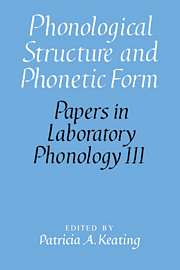1 - Introduction
Published online by Cambridge University Press: 26 February 2010
Summary
This volume continues the series Papers in Laboratory Phonology, comprising papers and commentaries from the Third Conference in Laboratory Phonology (LabPhon3), which was held at UCLA in June 1991. Most of the papers and some of the commentaries from the conference are included here, in revised versions. Some of the contributors participated in one or both of the previous Laboratory Phonology conferences, while others are new. The conference also included poster presentations, which are not represented in this volume.
The papers have been organized here into four topical sections. The first is concerned in various ways with intonation: a model of stress and accent and its relation to stress shift and to articulatory data (Beckman and Edwards/Shattuck-Hufnagel); pitch accent and its Fo scaling (Ladd/Hayes); and the acoustics and perception of contrastive focus (van Heuven/Jongman). The second section is concerned with syllable structure and phonological theory: how syllabic affiliations might be determined from phonetic data (Turk/Rialland/Nolan), and the import of statistical regularities in lexical data (Pierrehumbert). The third section is concerned with phonological features: arguments for a natural class of pharyngeal place of articulation, and its phonetic basis (McCarthy/Goldstein), and the relevance of hierarchical representation of features to continuing work on their acoustic correlates (Stevens/Goldstein). The last section is concerned with what can be called “phonetic output”: how, as a result of sound change, different speakers realize the same phonological units in different phonetic ways (Yaeger-Dror), how a formant speech-synthesis system can be improved by improving its underlying phonological theory (Coleman/Johnson), how an articulatory speech-synthesis system gets its mouth open (Browman/Kingston).
- Type
- Chapter
- Information
- Phonological Structure and Phonetic Form , pp. 1 - 4Publisher: Cambridge University PressPrint publication year: 1994
- 2
- Cited by



